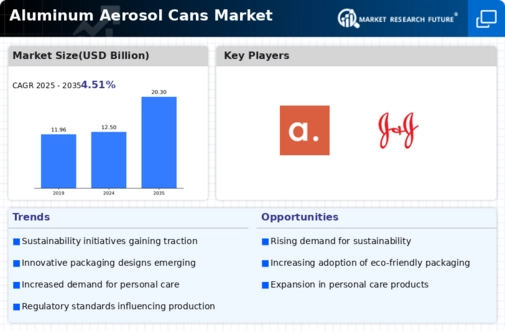Aluminum Aerosol Cans Size
Aluminum Aerosol Cans Market Growth Projections and Opportunities
Aluminum Aerosol Cans Market Size was valued at USD 1.7 Billion in 2022. The Aluminum Aerosol Cans industry is projected to grow from USD 2.04 Billion in 2023 to USD 8.77 Billion by 2032, exhibiting a compound annual growth rate (CAGR) of 20.00%
The aluminum aerosol cans market is subject to various market factors that shape its trajectory within the packaging industry. Sustainability stands out as a significant factor influencing the dynamics of this market. With a growing emphasis on eco-friendly packaging solutions, aluminum aerosol cans are gaining popularity due to their recyclability and lightweight nature. Aluminum is infinitely recyclable, making it an environmentally responsible choice for both consumers and businesses. As environmental awareness increases, the demand for sustainable packaging options like aluminum aerosol cans continues to rise, driving market growth.
Economic factors also play a pivotal role in the aluminum aerosol cans market. Economic conditions, consumer spending habits, and industrial activities impact the demand for packaging materials. In times of economic growth, there is typically an increase in production and consumption of goods, leading to higher demand for packaging solutions, including aluminum aerosol cans. Conversely, economic downturns may result in reduced production and consumption, affecting the market negatively. Stakeholders in the aluminum aerosol cans industry must monitor economic trends to adapt to market fluctuations effectively.
The regulatory landscape significantly influences the aluminum aerosol cans market. Regulations related to product safety, labeling, and environmental impact shape the manufacturing, distribution, and use of aluminum aerosol cans. Compliance with recycling and sustainability standards is crucial for industry players to meet regulatory requirements and maintain market relevance. Government initiatives promoting the use of recyclable materials also contribute to the market dynamics, encouraging businesses to adopt aluminum aerosol cans in their packaging strategies.
Technological advancements in manufacturing processes are key factors driving innovation in the aluminum aerosol cans market. Advances in can shaping, printing technologies, and coating techniques contribute to improved aesthetics, functionality, and cost-effectiveness. Manufacturers that invest in state-of-the-art production technologies can gain a competitive edge by offering high-quality and customizable aluminum aerosol cans. Additionally, innovations in valve and dispensing systems enhance the performance and user experience of aerosol products, influencing consumer preferences and market trends.
Consumer preferences and perceptions play a crucial role in the aluminum aerosol cans market. As consumers become more conscious of environmental issues, there is a growing demand for packaging solutions that align with sustainability goals. The lightweight and recyclable nature of aluminum aerosol cans resonate with environmentally conscious consumers. Additionally, the versatility in design, shape, and printing options allows manufacturers to cater to evolving consumer preferences, contributing to brand loyalty and market success.
Market competition in the aluminum aerosol cans industry is shaped by factors such as pricing, branding, and distribution channels. Competitive pricing strategies that consider production costs, raw material prices, and market demand influence a company's market position. Building a strong brand reputation for reliability, quality, and sustainability is essential for attracting and retaining customers. Effective distribution networks and partnerships with retailers contribute to market accessibility and competitiveness. Manufacturers and distributors must navigate these competitive factors strategically to establish a strong presence in the aluminum aerosol cans market.







Leave a Comment